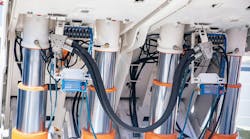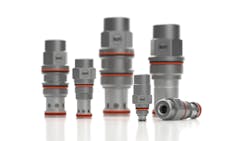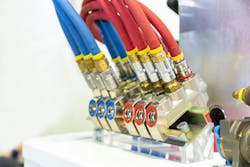Pneumatic Control for Hydraulic Systems: Benefits and Applications
Pneumatic control is one of several methods which can be used for hydraulic systems. “Every hydraulic system requires some sort of control system,” said Steve Weber, Regional Application Specialist at Sun Hydraulics.
These can include manually actuated valves or electrically actuated solenoid valves – commonly referred to as electrohydraulic valves – both of which can be switching or proportional. Commands are sent from human machine interfaces (HMI) such as electronic joysticks and programmable touchscreens as well as programmable logic controllers (PLCs) or industrial computers.
Advantages of Using Pneumatically Controlled Hydraulic Systems
Pneumatically controlled hydraulic systems can benefit many applications, especially those where safety may be a concern or where pneumatics is already being utilized.
Weber said many industrial machines rely upon pneumatic controls. “These machines may be hydraulically actuated but also have some pneumatics on them,” he explained. “It can sometimes be more convenient to control the hydraulic system with pneumatics in this example over introducing a new control system such as electro-hydraulic valves.”
In this situation, there is no need to install additional equipment as all necessary components for pneumatic supply are already available. This not only eases implementation for machine owners but also reduces potential installation costs. An electro-hydraulic system, on the other hand, would require the installation of electrical wires, power supplies and other accessories which could drive up costs.
However, pneumatically controlled systems tend to have a slower dynamic response time compared to electro-hydraulics which should be taken into account based on the application’s requirements.
Weber said pneumatic control for hydraulic systems can also be the right marriage of technologies for hazardous environments where the use of explosion proof coils for electro-hydraulic valves would be required. “These ATEX/CSA rated explosion proof (EX) coils can be very expensive,” he said. “The use of pneumatic control might be a cost-effective option that provides the needed safety in these environments.”
Examples of these applications outlined by Sun Hydraulics include:
- oil drilling platforms
- oil and gas handling equipment
- chemical industry equipment
- dust-laden atmospheres (grain elevators)
- vehicular lifts
- sawmills.
As there are often combustible or explosive materials present in these types of applications, electrical devices used in them are required to meet “Intrinsically Safe” or “Explosion Proof” standards. This means they are designed to prevent heat or a spark sufficient to cause an explosion, even if the device is worn or damaged.
“Applications where heat generation is problematic from high duty cycle use of a solenoid coil might be solved with pneumatic control,” said Weber.
Environments with strong electromagnetic fields can be a concern as well if using electro-hydraulic control. Large currents or “noise” can be created which can lead to false signals being sent to sensitive electro-hydraulic devices.




